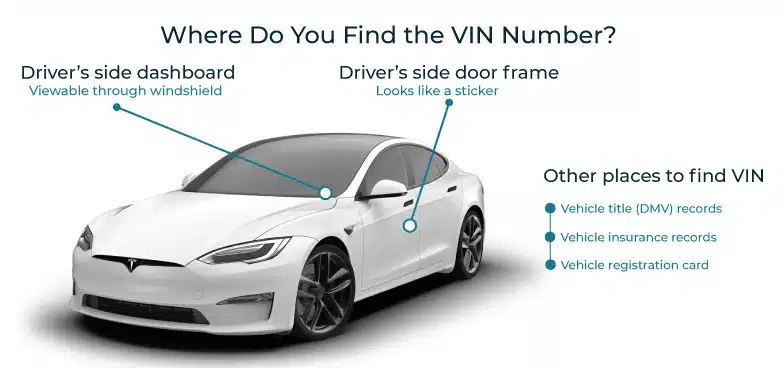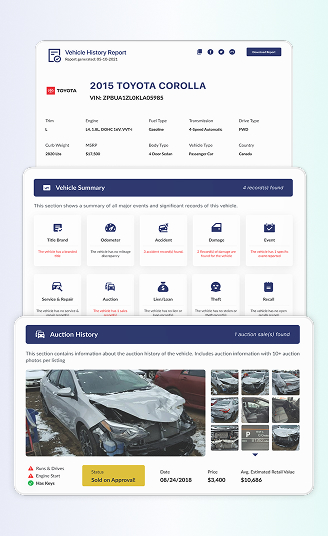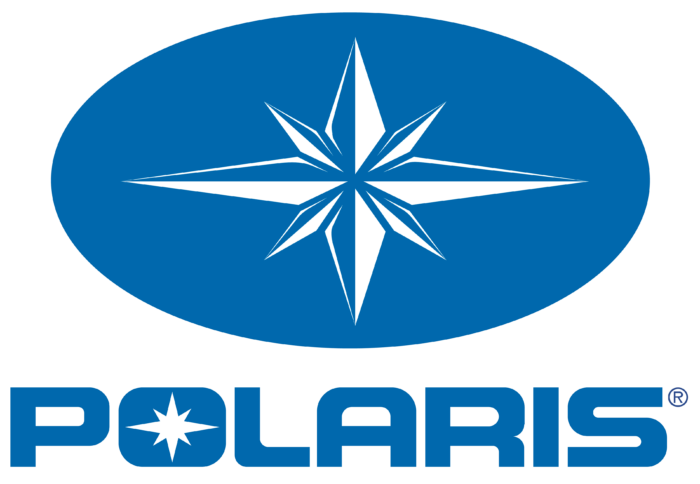
Polaris Recall Check
Uncover safety risks instantly with Polaris Recall Check. Enter your VIN, get verified recall data in seconds, and drive with confidence. No surprises! Just clarity.
What is a Polaris Recall?
A Polaris recall happens when Polaris or the National Highway Traffic Safety Administration (NHTSA) finds a safety or compliance defect, such as fire risks, loss of braking, electrical faults, or parts that can fail under load. When that happens, owners are notified and dealers perform a no-cost remedy (repair, replacement, or, rarely, refund/buyback).
Recalls are tracked by the U.S. Consumer Product Safety Commission (CPSC) and often have a companion page at the manufacturer. You don’t have to guess! Your VIN tells you everything.
Why You Should Check the Polaris Recall History?
Running a Polaris Recall Check is important for used car buyers because it helps to ensure the safety and reliability of the vehicle. Below are some reasons why you should check the recall:
Avoid Unsafe Polaris
Unfixed recalls can lead to fire, stalling, or loss of control. Catching them early keeps you and your passengers out of harm’s way. For example, certain 2023–2024 Sportsman 850/XP 1000 ATVs were recalled for fuel pump flange leaks that could ignite near hot components. Free dealer fixes are available.
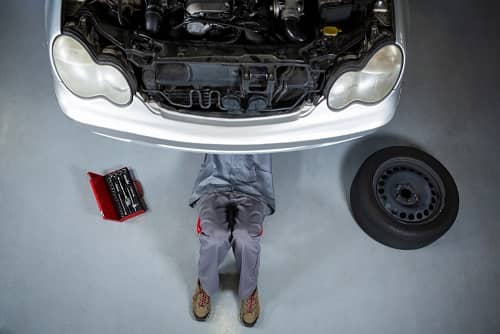

Compliance
Staying compliant isn’t paperwork, it’s protection. Handling recalls promptly keeps your machine safe for riders, helps you meet federal safety requirements, and prevents headaches like insurance pushback or title/resale trouble later on.
If you’re buying used, checking first means you’re not inheriting a vehicle that’s out of compliance and potentially harder to register or sell down the road.
Resale Value
A vehicle with open recalls may have a lower resale value than one without any recalls. By running a Polaris Recall Check and addressing any open recalls, you can help maintain the value of the Polaris vehicle.

How to Run Polaris Recalls?
Discovering your Polaris recall report is just a minute away! Follow these easy steps to get the information you need quickly and effortlessly:

Locate Your Polaris VIN
You'll need your Vehicle Identification Number (VIN). It’s stamped on the frame (often front-left or left-rear wheel well). Your Owner’s Manual shows the exact spot for your model. Our lookup service works on any type of Polaris, classic or current.


Fill in the Form
Drop the VIN in the form above. No VIN handy? Use your license plate instead.


Receive Your Polaris Recall Report
Your Polaris recall report will appear shortly with any open campaigns and remedies. So you can schedule any free fixes.
What is on the Polaris Recall Check?
In the Detailed Vehicle History, a Polaris recall check shows detailed information about safety recalls affecting your vehicle. Each record outlines when the recall was announced, which component is impacted, and what action you should take. Read further to see the detailed breakdown:
- Date of recalls: Indicates when Polaris and NHTSA issued the recall.
- Affected Component: The report identifies the exact Polaris part at fault, describes the defect, and explains the repair steps
- Consequences: Learn the possible impacts on drivability, efficiency, and safety so you know what’s at stake.
- Next step for the affected Polaris: Confirm if your Polaris is listed under the recall and schedule repairs. With a complete Vehicle Report, you’ll also see past recalls and repair status.
A Polaris vehicle history report also includes title check, accident records, auction History, warranty status/coverage, and more.
Review the records below for further explanations:
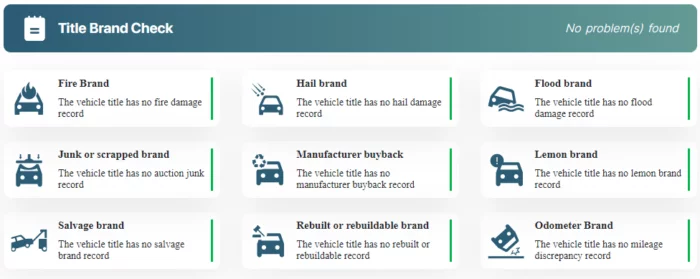
Title Check
Checking the title isn’t optional. Our report flags Polaris-branded titles, includes salvage, rebuilt, flood, fire, hail, junk, and more, so you understand risk, negotiate price, or walk away with confidence.
Accident Records
Check how many accidents a Polaris has seen and how severe they were. Reports can reveal frame, suspension, or drivetrain hits. Use that insight to plan repairs and negotiate a price.
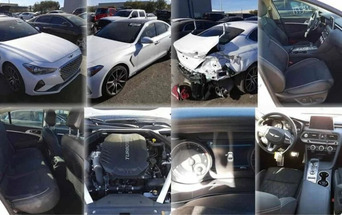
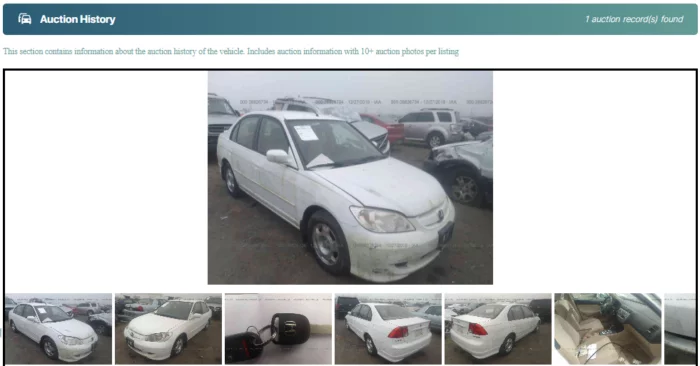
Auction History
See a Polaris’s auction trail, with sold or no-sale events, hammer prices, lane notes, and up to 10+ photos when available. So you can gauge market value and spot prior damage or flip attempts.
Warranty Status/Coverage
Is your Polaris still covered? Check powertrain, emissions, and any remaining factory or extended plans. Knowing coverage helps you budget repairs and schedule dealer fixes smartly.


Past Vehicle Usage
Learn how your Polaris was used, such as personal trail rides, rental fleet, commercial ranch work, police, or lease. Usage patterns affect wear, maintenance schedules, and price. Know the story before you commit.
Vehicle Summary
Your Polaris at a glance: ownership timeline, title status, recalls, usage type, and reported accidents. A quick scan to spot risks early and avoid surprises later.
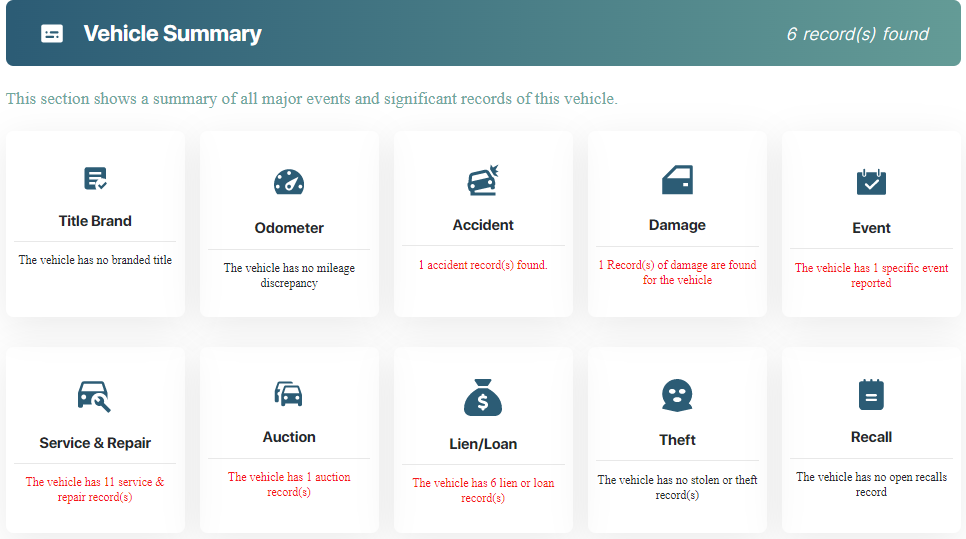
Common Issues Leading to Polaris Recall
Polaris vehicles have faced several recalls due to safety and reliability concerns. Common issues in the Polaris range from fire hazard risk, braking defects, and other notable issues.
Below are some of the causes behind the Polaris recall notices.
Fire Hazards
Fuel-Pump Flange Outlet Defect
Fuel-Pump Flange Outlet Defect Leading to Polaris Recall (Sept 19, 2024): Polaris confirmed that certain 2023–2024 Sportsman 850, XP 1000, and XP 1000 S ATVs, and specific service parts, can leak fuel at the pump flange outlet. Leaked fuel may hit hot components and spark a fire. A Stop Ride/Stop Sale was issued July 3, 2024, and a formal CPSC recall followed September 19, 2024 (No. 24-369).
Affected service parts include fuel-pump kits 2208595/2208596 and fuel-tank assemblies 2522378/2522379. Run a Polaris Recall Check with your VIN, then schedule the free dealer repair. Ride safe, fix fast.
Supplier Defect At The Fuel-Pump Outlet Connector
A supplier manufacturing defect at the fuel-pump outlet connector prompted Polaris to recall multiple off-road lines. Polaris issued a Stop Ride/Stop Sale on December 12, 2022, expanded the population on May 31, 2023, and announced a formal recall on August 10, 2023.
Impacted vehicles include MY 2021–2023 RANGER 1000/XP 1000, MY 2021–2022 RZR Pro XP, MY 2021–2022 Pro XD, plus select Bobcat (2021–2023) and Gravely (2021, 2023) utility vehicles. The defect can let fuel leak near hot parts, increasing the fire risk, with dealers replacing the pump or tank for free.
Fuel Leak At The Pump-Flange Assembly
On September 19, 2024, Polaris and the CPSC recalled select 2023–2024 Sportsman 850, XP 1000, and XP 1000 S ATVs for a fuel leak at the pump-flange outlet, a flaw that can send fuel toward hot parts and spark a fire.
The action also covered service parts, which are the fuel-pump kits 2208595/2208596 and fuel-tank assemblies 2522378/2522379. If you ride one, park it, run a Polaris Recall Check by VIN, and book the free dealer fix.
Battery Terminal Exposure
On December 5, 2024, Polaris recalled select MY 2024–2025 RZR XP 1000 and XP 4 1000 after finding that the red battery terminal cover can be damaged by the seat base. If the positive post gets exposed and touches metal, it can short and ignite. About 21,000 units were affected in the U.S. Check your VIN with Polaris Recall Check, follow any Do Not Ride guidance, and let a dealer handle the fix.
Charging-System Defect
On June 18, 2025, Polaris and the CPSC recalled 2023–2024 Ranger XP Kinetic and 2025 Pro XD Kinetic after a cracked filter could let water reach the high-voltage charging harness, shorting the system while charging and posing a fire hazard. Park it, charge outdoors only, and schedule the free fix (protective cover and, if needed, new harness).
Braking Defects
Improperly Installed Center Brake Line
On November 9, 2023, Polaris recalled certain 2023 RANGER XP 1000 NorthStar / Crew because a center brake line was installed wrong. This was dangerous because the rear circuit can stay pressurized, cooking the brakes and reducing braking, with a real fire risk. The recall affected about 1,000+ U.S. units, with a fire incident already on record.
Other Notable Issues
Filler-Neck Clamp/Cover
On January 5, 2023, Polaris announced a recall for Model Year 2020–2023 Sportsman 1000 S and Scrambler 1000 S ATVs. The fuel filler-neck clamp/cover could let static outside the tank ignite spilled fuel during refueling. A pure fire risk.
About 3,800 units were affected in the U.S., with 16 fires reported abroad. Dealers install new clamps and, if needed, a fill-neck cover free.
Understanding the Polaris Recall Process
The NHTSA begins the recall process by investigating reported issues. If a defect is found, the manufacturer must issue a recall. See the steps of their process below.
Report the Problem
Spot something wrong with your Polaris? File a complaint with NHTSA. Your report gets logged, matched against other VINs, and when patterns emerge, it can spark an official safety investigation. Your voice moves the needle.
Investigation
Once a complaint is submitted, the NHTSA follows a multi-step process to determine whether a recall is necessary.
- Screening: Owner complaints are reviewed for credibility and supporting evidence. If the pattern looks real, NHTSA moves the case forward for deeper review.
- Analysis: Formal defect petitions get a detailed evaluation. If a petition is denied, the decision (and the reasoning) is published in the Federal Register for full transparency..
- Investigate the Issues: When Polaris’s safety concerns are substantiated, NHTSA opens an official investigation. It concludes with either no defect found or a recall with a defined remedy.
- Recall Management: NHTSA manages the process end-to-end: it verifies owner notifications and audits repair completion rates.
Recalls
A safety recall means the automaker must tell owners and fix the defect. Recalls happen when a vehicle or part is unsafe or breaks the rules. Most are voluntary, and repairs, replacements, refunds, or buybacks are provided.
How Polaris Vehicle Recalls Are Handled?
When a safety issue occurs in a Polaris, three key groups are involved in the recall process: the manufacturer/ automaker, NHTSA, and you, as the vehicle owner. They work together to detect defects, notify drivers, and ensure repairs are completed to keep vehicles safe.
Automaker Role
Polaris’s job starts the moment a defect is confirmed: issue guidance (often a “Stop Ride/Stop Sale”), notify the regulators (NHTSA), publish a recall, and tell owners and dealers what to do next. They supply parts and procedures so authorized dealers perform free remedies. Dealers log completions; Polaris monitors progress and updates notices if needed. In short: identify, alert, repair, verify.
NHTSA’s Role
NHTSA is the federal referee in Polaris recalls. Its Office of Defects Investigation (ODI) screens complaints, opens investigations when trends appear, and can press manufacturers to recall. Once Polaris files a Part 573 defect report, NHTSA reviews it, posts public details, and requires timely owner notices (usually within 60 days) plus quarterly progress reports. Oversight continues until remedies are complete.
Your Role as the Vehicle Owner
Your job is simple but crucial: check for recalls, follow “do not ride” guidance if issued, and book the free dealer fix. Start by running a VIN search with our Polaris Recall Check to pair recall status with deeper vehicle history, so you know what’s fixed, what’s pending, and what to plan next.
Get Polaris Window Sticker by VIN
A Polaris window sticker reveals factory specs, standard/optional equipment, original pricing, and installed packages. Straight from the build data.
Use it to confirm feature lists, evaluate upgrades, and justify price during negotiations. Combined with a Polaris Recall Check, you’ll validate safety status and equipment in minutes. Fewer surprises, smarter decisions, and a cleaner paper trail when it’s time to sell.
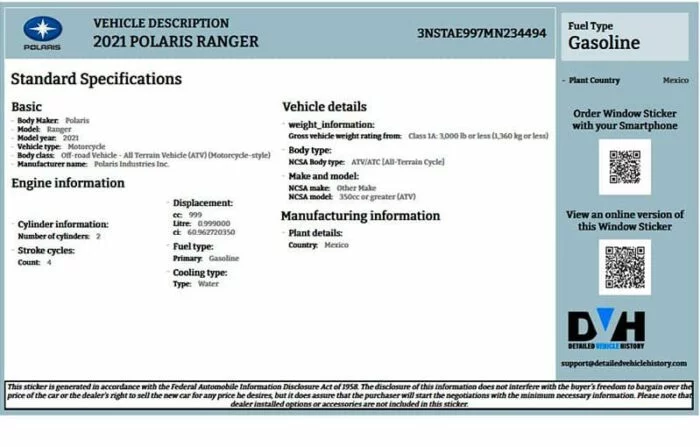
Why Use Detailed Vehicle History to Check Polaris Recall?
Shopping, selling, or just sanity-checking your machine? Run a Polaris Recall Check and get the full report: recalls with remedy guidance, title check, accident records, auction History, warranty status/coverage, and more!
You’ll spot red flags early, price fairly, and keep paperwork ready for the next owner. Clean, connected data beats guesswork and protects your wallet on day one.
Recall Check For Others Manufacturers
FAQ about Polaris Recalls Check
Is a Polaris recall free?
Yes. Polaris safety recalls are free at authorized dealers. Check your VIN, book the appointment, and you’re done. If a “Do Not Ride” is issued, park it until repaired.
How long do Polaris recall repairs usually take, and what delays should I expect?
Some fixes take about an hour once parts are in stock; timing depends on dealer scheduling and parts availability. For exact timing, contact a dealer, who’ll confirm parts and slot you in.
Which site is best for a Polaris recall check?
Polaris Recall Check by Detailed vehicle History tells you beyond the basics open recalls, but also the past recalls with details, plus title check, accident records, warranty status/coverage, and even auction photos when available.
How do I know if a recall repair was actually completed on my Polaris?
Start with the Polaris VIN search. If it lists the recall and shows UNAPPLIED, call a dealer and book the fix; after service, the line should update to APPLIED. On Slingshot (on-road), also check the NHTSA VIN tool for completion status. Save the work order in your records.
Can a Polaris recall expire or still apply if I’m the second owner?
Recalls follow the VIN, not the owner. If your Polaris is covered, the fix is free at an authorized dealer, even if you’re the second (or fifth) owner.
Use the Polaris recall check lookup to confirm, then book the service. Some notices add timing on mailers, but the safety remedy remains available once parts exist.
What if there’s no fix yet for my Polaris recall? Can I get a loaner or workaround?
When a recall launches before a remedy is ready, follow the interim guidance (e.g., Do Not Ride, park outside, charge outdoors).
Ask your dealer about loaners. Manufacturers are often encouraged to assist when use is restricted. Stay on the list for parts and recheck your VIN weekly.
What’s the safest way to ride or store my Polaris while I wait for recall parts?
Follow the notice exactly. If it says Do Not Ride, park it. If allowed to use, stick to light duty, inspect the flagged area before/after rides, and store outdoors and away from structures. Especially for the fire-risk campaigns.
Will an open Polaris recall affect insurance or financing?
Insurance usually won’t change your rate just for a recall, but an open safety defect can influence underwriting or a lender’s comfort. Especially if there’s a Do Not Ride order. Close the recall to avoid friction, and keep the documentation.
Do recalls hurt Polaris trade-in value if I have proof the fix was done?
Think of it as reputation management. A clean recall record plus a Polaris Recall Check and (optionally) a Polaris Window Sticker by VIN gives buyers confidence, and may even support a stronger price.
Could a recall void my Polaris warranty or extended coverage?
Recalls don’t “void” coverage. They fix safety defects at no cost. What hurts is ignoring them. If a failure is caused by an unfixed recall, you may face denials. Complete the repair and keep the paperwork.
What happens if my Polaris has no open recalls but shows symptoms?
Document everything, stop riding, and report it: contact your dealer, then file a safety complaint (CPSC for off-road; NHTSA for Slingshot). Patterns trigger investigations and recalls.
Can recalls apply to Polaris accessories or service parts I installed later?
Yes. Some Polaris recalls explicitly include service parts. For example, the Sportsman campaign also covered fuel-pump kits and fuel-tank assemblies sold separately. If you installed those parts, you’re included.
Check the notice for part numbers, then run your VIN and contact the dealer with your receipt.
How do I reset or update my Polaris ECU after a recall repair?
If the machine behaves oddly after a recall, call the dealer who performed the work. They can recheck calibrations and reflash if needed under the same campaign.
What are the common problems on Polaris 1000 XP that can lead to recalls?
As of September 2025, common recall causes on Polaris 1000 XP are that the positive battery terminal can become exposed if the seat damages its cover, creating a fire risk. And some front brake lines were routed where they could rub the tire or wheel, reducing stopping power. Dealers repair these issues at no cost.
Is there a class-action lawsuit related to recent Polaris recalls?
Possibly. Class-action cases related to Polaris fire hazards have been filed in the past, and new ones sometimes emerge. These do not replace a recall; they run in parallel. If you think you’re affected, get the free recall fix now and review current lawsuit notices or consult counsel about your options.

